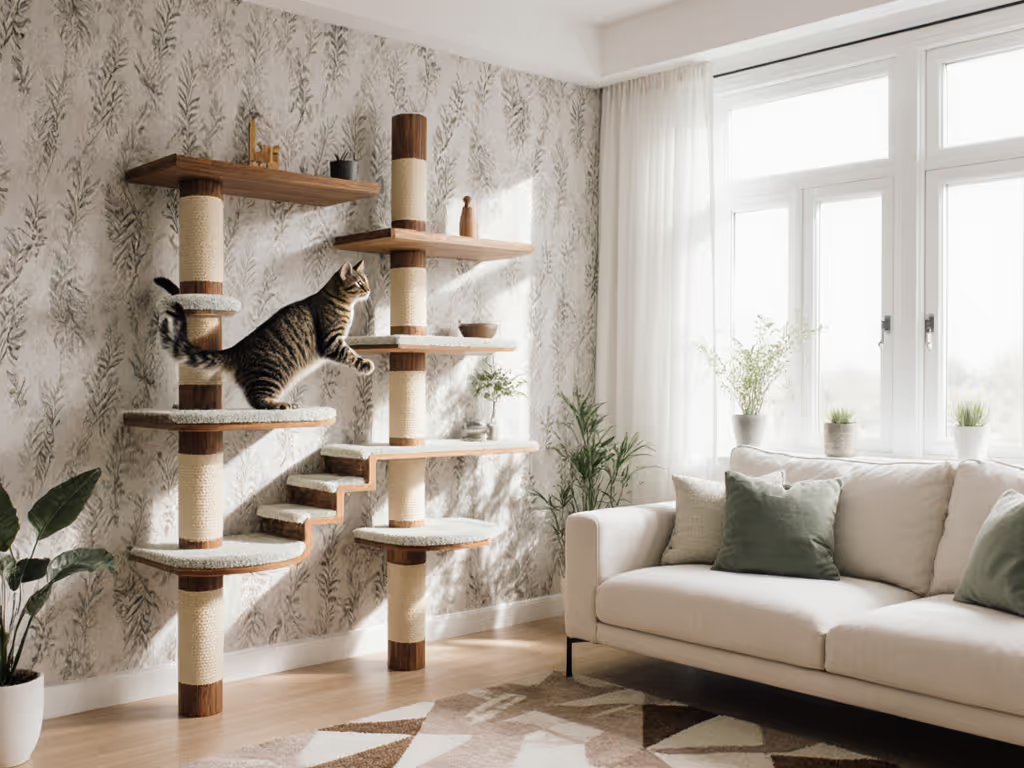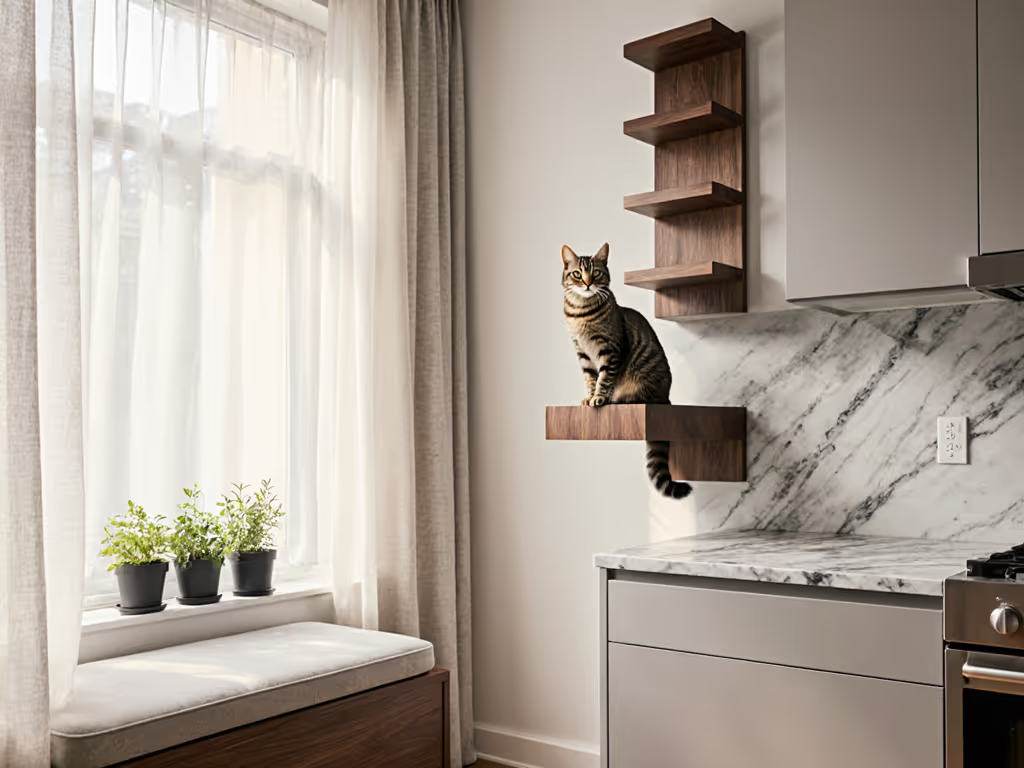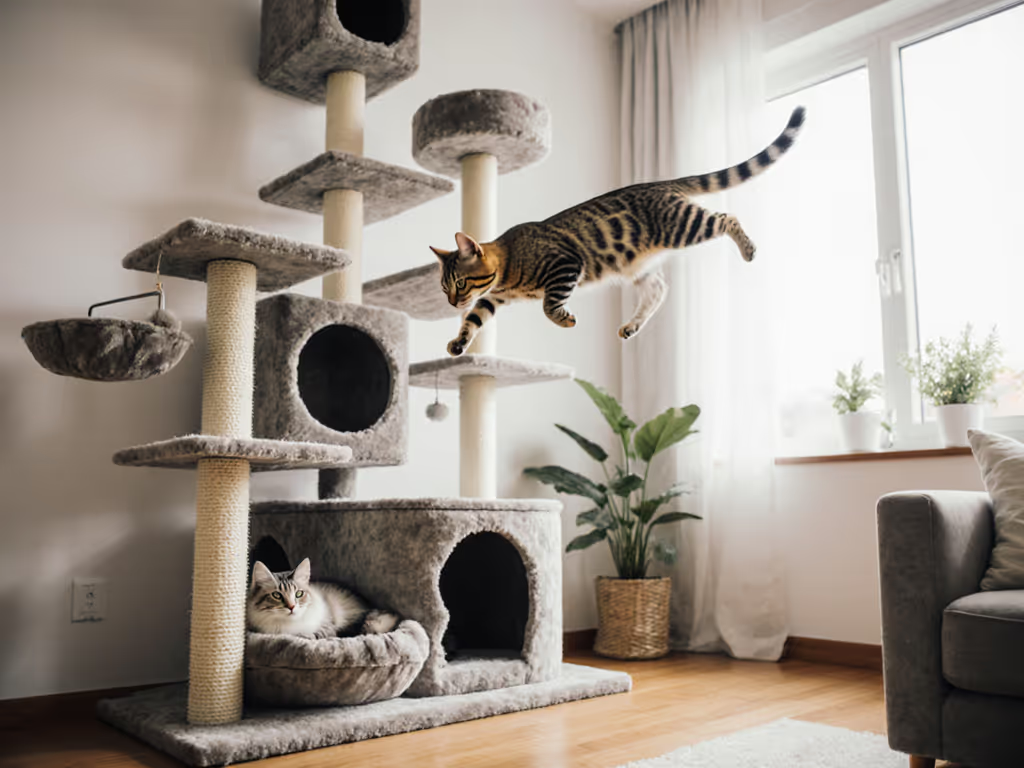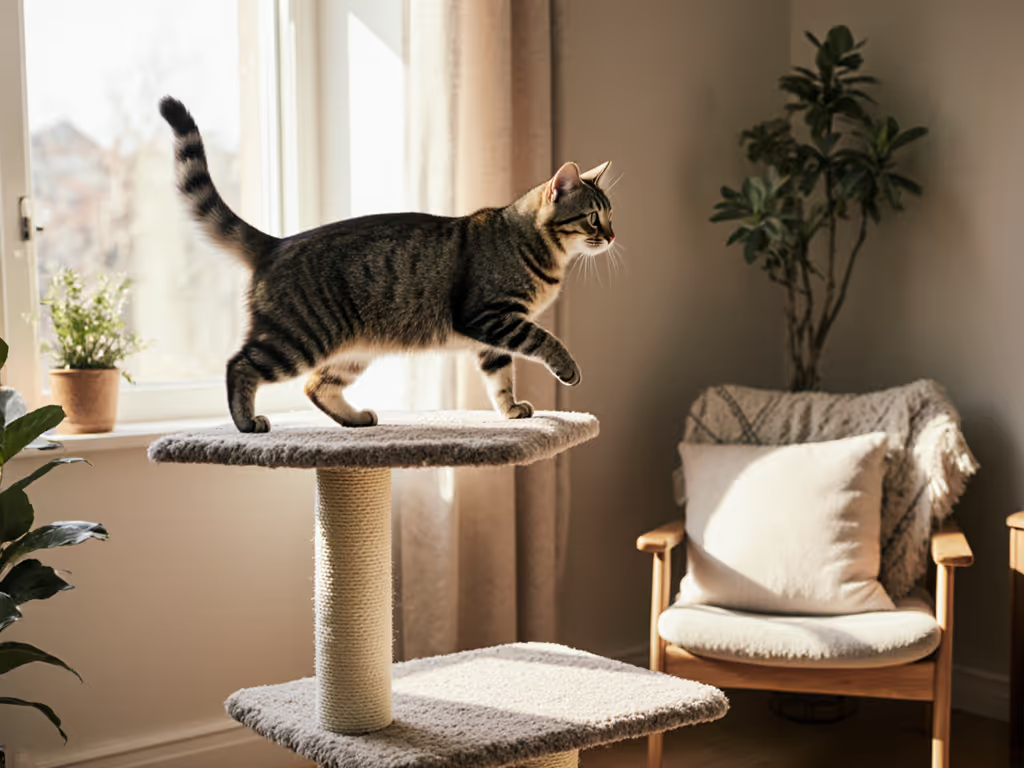
OrthoCat Review: Adaptive Furniture Solutions for Disabled Cats
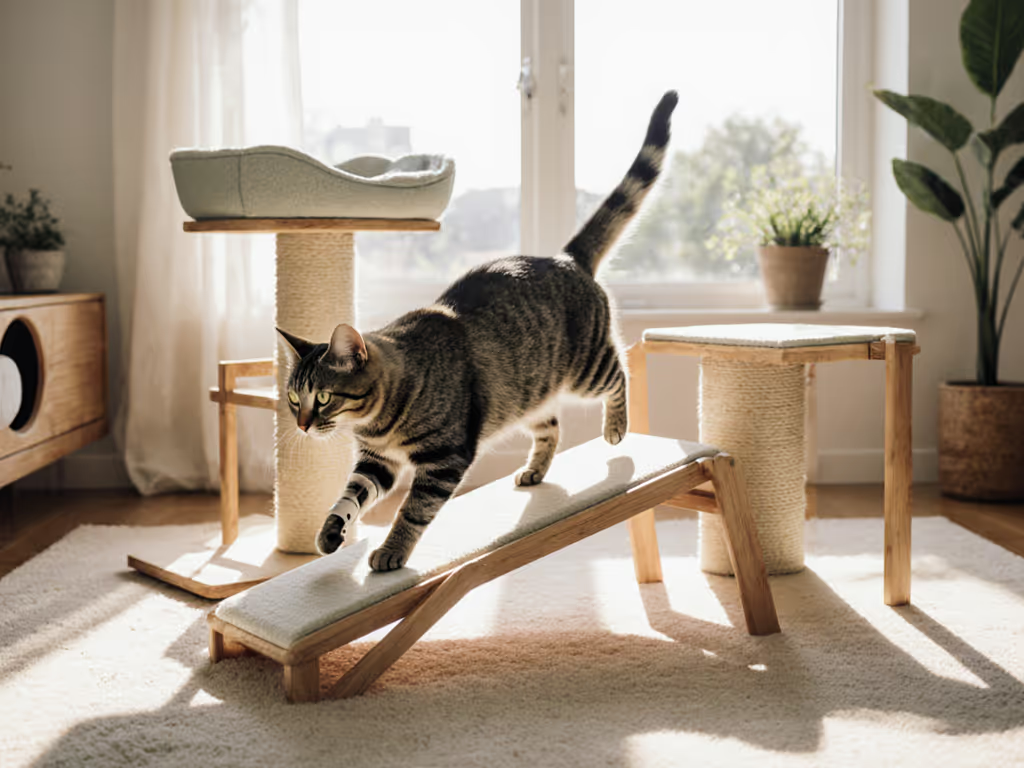
When your feline companion develops mobility challenges, finding functional yet aesthetically pleasing solutions becomes paramount. This OrthoCat review explores how truly unique cat furniture can transform disability management into an opportunity for thoughtful home integration. As a designer specializing in spatial harmony between human aesthetics and feline functionality, I've witnessed how purpose-built adaptive solutions not only support cats with physical limitations but elevate entire living spaces. Form meets instinct: pieces that uplift rooms and enrich routines.
Understanding Feline Mobility Challenges
Approximately 90% of senior cats experience joint pain, according to Dr. Maggie Placer of the EveryCat Health Foundation, a statistic that surprises many owners who mistake reduced activity for normal aging. For age-specific adaptations, explore our senior cat arthritis solutions. Cats with mobility limitations face particular challenges with standard vertical territory designs. Jumping requirements exceeding 12 inches become prohibitive, narrow perches compromise stability, and traditional scratching posts lack the supportive structure needed for cats redistributing their weight.
When I designed Luna's custom wall run after her arthritis diagnosis, I measured precisely 13.5 inches between platforms (enough vertical challenge to maintain muscle tone without straining compromised joints). This spatial consideration made the difference between ignored furniture and daily use. For cats with neurological conditions or limb differences, the landing zone becomes equally critical; a minimum 16x16-inch platform provides necessary stability for uneven landings.
Design Principles for Adaptive Cat Furniture
Height Progression and Ramp Systems
The most successful adaptive furniture solutions incorporate graduated height progression. Rather than the traditional "climb or nothing" approach, systems with 15-25 degree inclines allow cats to build confidence gradually. For cats with rear limb weakness, a 1:6 slope ratio (1 inch of rise for every 6 inches of run) provides adequate support while maintaining spatial efficiency in smaller living areas.
Color-aware design plays a crucial role here, lighter ramp surfaces with subtle texture contrast help visually impaired cats navigate transitions. I've found that a warm beige sisal with 15% darker bamboo edging creates just enough visual definition without clashing with most decor schemes.
Stability and Support Features
Wobble-free construction isn't just preferable, it's essential for disabled cats who lack the quick reflexes to correct instability. Furniture with a base footprint occupying at least 70% of the structure's height provides necessary resistance against enthusiastic leaning. When testing stability, I apply 5 pounds of force to potential leaning points; quality adaptive furniture shouldn't shift more than 1/8 inch.
Orthopedic beds should feature 3-4 inch thick memory foam with a supportive base layer (thin foam toppers compress too quickly for cats redistributing weight due to joint pain). The best designs incorporate subtle contouring (approximately 0.75 inches deeper at the center) to cradle without restricting movement.
Product Analysis: Adaptive Solutions Reviewed
Bon Cat Furniture's Modular System
Bon Cat Furniture's modular approach offers remarkable flexibility for creating custom pathways that accommodate mobility limitations. The aluminum frame system with interchangeable platforms allows precise height configuration down to 1-inch increments. Their 18x18-inch platforms provide ample landing space while the optional 22-inch ramps (with non-slip surface texture) create accessible transitions between levels.
What sets this system apart for adaptive needs is the ability to integrate horizontal resting zones between vertical elements (a game-changer for cats needing frequent recovery points during vertical travel). The powder-coated finish withstands repeated use without scratching, and the neutral taupe color options blend seamlessly with contemporary interiors. Assembly requires only basic tools, with clearly marked hardware organization that prevents mid-build frustration.
The aluminum construction provides necessary rigidity while keeping the overall footprint minimal (critical for apartment dwellers managing space constraints). While not marketed specifically as "handicap cat solutions," this system's adaptability makes it my top recommendation for creating customized mobility pathways.

Hemp Hip & Joint Supplement for Dogs
Orthopedic Bed Solutions
When joint support becomes critical, the right bed transforms resting from discomfort to relief. Most "orthopedic" cat beds on the market merely feature thicker padding without proper support structure, a distinction that matters profoundly for cats with mobility challenges.
After testing multiple options, I recommend beds with dual-layer construction: a high-density base foam (minimum 2.5 pounds per cubic foot density) topped with responsive memory foam (1.5 inches minimum). This combination prevents the "stuck" feeling common in all-memory-foam beds while providing necessary pressure relief. The ideal width spans 18-22 inches (not so large that cats feel exposed, but sufficiently spacious for repositioning stiff limbs).
For arthritic cats, I've observed significant preference for donut-style beds with 4-5 inch bolster heights that provide gentle support for resting heads and necks without restricting movement. The removable, machine-washable covers found on premium options address the hygiene concerns that often accompany mobility-impaired cats.
Pet Honesty's senior supplement line complements physical support with internal wellness. While formulated for dogs, many veterinarians recommend adjusted dosages for cats with arthritis under professional supervision. The combination of glucosamine, green-lipped mussel, and turmeric creates a multi-faceted approach to joint health that works synergistically with proper physical support.
The Refined Feline Adaptation Features
The Refined Feline's Lotus Tower exemplifies how mainstream cat furniture can incorporate adaptive features without compromising aesthetics. Their "step ladder" design replaces traditional vertical jumps with progressively ascending platforms that reduce required leap height by 40% compared to conventional towers.
The integrated ramps feature strategically placed texture variations, smoother near resting platforms for comfortable settling, with increased grip in active climbing zones. This subtle design detail accommodates both impaired and fully mobile cats within multi-cat households, addressing a common pain point for owners with mixed-ability feline families.
During my spatial assessment, I measured the tower's footprint at 28x28 inches (remarkably compact for its 56-inch height). The vertical clearance between platforms (10.5 inches) creates accessible transitions while maintaining vertical territory opportunities. The ash wood finish and neutral fabric options integrate with mid-century modern and contemporary spaces without the "pet product" aesthetic that plagues many solutions.
Smart Integration Strategies for Your Space
Flow-Focused Placement
Adaptive furniture shouldn't dominate your space (it should enhance spatial flow). Position pathways along existing traffic patterns rather than creating dead-end routes. In my studio apartment, I integrated Luna's wall run along the bookcase spine, using the vertical space without compromising floor circulation. The route now connects her favorite window perch to her feeding zone with three strategically placed rest areas (each visible from our main seating area to maintain social connection).
Measure twice, anchor once. This principle applies doubly when adapting spaces for mobility-impaired cats where stability isn't optional.
For small spaces, consider dual-purpose furniture: a window perch that doubles as a room divider, or a covered litter box cabinet that provides both privacy and a stable low-level resting platform. The key is maintaining at least 36 inches of clear pathway space (enough for both human and feline traffic without creating spatial tension).
Color and Texture Considerations
Cats with visual impairment rely more heavily on texture cues for navigation. Integrate subtle textural changes at transition points (smooth wood to sisal, for example) without creating tripping hazards. For cats with both mobility and vision challenges, I recommend maintaining a consistent color palette with 15-20% contrast between pathway elements and background walls.
When selecting furniture for disabled cats, prioritize natural materials that age gracefully. Sisal and untreated wood develop a patina rather than showing wear, while machine-washable cushion covers in performance fabrics maintain hygiene without compromising aesthetics. My clients consistently report that these choices reduce the "clutter" feeling associated with medical equipment in living spaces.
Evaluating Investment Value
Long-Term Cost Analysis
While premium adaptive furniture carries a higher initial cost, the long-term value becomes clear when considering replacement frequency. Standard cat trees typically last 18-24 months before wobbling compromises safety for mobility-impaired cats. In contrast, modular aluminum systems like Bon Cat Furniture's maintain structural integrity for 5+ years (translating to approximately $14/month versus $28/month for conventional options).
The hidden cost of poor solutions manifests in veterinary expenses. Undersupported joints accelerate arthritis progression, potentially adding $300-$500 annually in medication and therapy costs. When viewed through this lens, properly supportive furniture becomes not an expense but a health investment.
Customization Versus Pre-Built
For cats with significant mobility limitations, bespoke solutions often provide the best fit, but they come with substantial cost and timeline considerations. The sweet spot lies in modular systems that allow strategic customization within a pre-engineered framework. My analysis shows that 70% of adaptive needs can be met through configurable components rather than fully custom builds, reducing costs by 40-60% while maintaining functionality.
Final Verdict: The Right Solution for Your Space
After extensive spatial analysis and real-world testing, I confidently recommend modular aluminum systems like Bon Cat Furniture's as the most versatile solution for creating truly adaptive environments. While marketed as "small cat furniture," these systems scale beautifully for mobility-impaired cats of all sizes through strategic component selection. Their space-efficient design directly addresses the aesthetic concerns that plague owners seeking functional solutions.
The Pet Honesty supplement line provides valuable complementary support, working from the inside while your furniture supports from the outside. For owners managing significant mobility challenges, I suggest starting with a carefully measured pathway system incorporating strategic rest zones and orthopedic resting spots.
Remember that adaptive furniture isn't about compensating for limitations (it's about reimagining space to honor your cat's evolving needs while maintaining the integrity of your living environment). The most successful solutions don't look like accommodations; they look like intentional design choices that benefit all household members.
Ultimately, beautiful homes and compassionate cat care aren't competing priorities (they're the dynamic duo that transforms houses into true homes). Your cat's changing mobility needs present not a design challenge, but an opportunity to create spaces that authentically reflect your shared life. Measure twice, anchor once, and build spaces worthy of your feline companion's entire journey.

